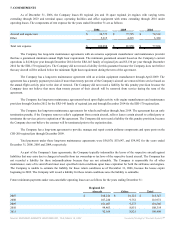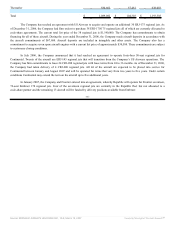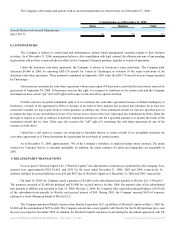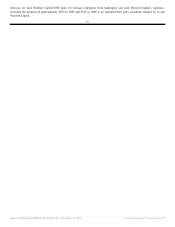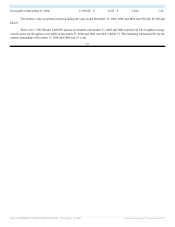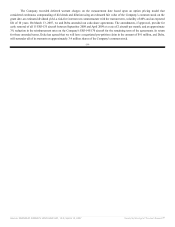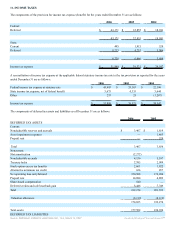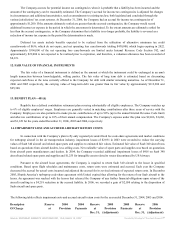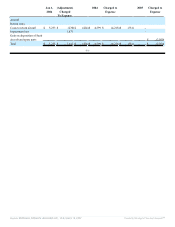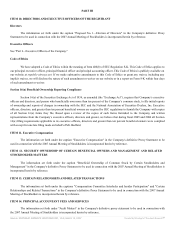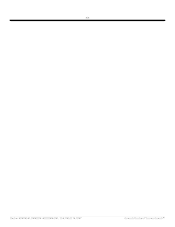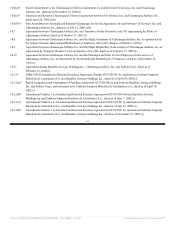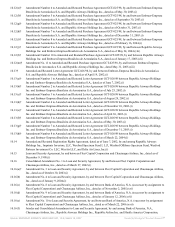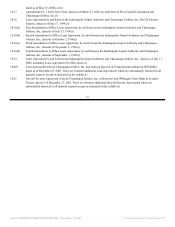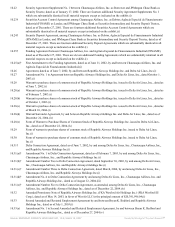Frontier Airlines 2006 Annual Report Download - page 108
Download and view the complete annual report
Please find page 108 of the 2006 Frontier Airlines annual report below. You can navigate through the pages in the report by either clicking on the pages listed below, or by using the keyword search tool below to find specific information within the annual report.
The Company accrues for potential income tax contingencies when it is probable that a liability has been incurred and the
amount of the contingency can be reasonably estimated. The Company’s accrual for income tax contingencies is adjusted for changes
in circumstances and additional uncertainties, such as amendments to existing tax law, both legislated and concluded through the
various jurisdictions’ tax court systems. At December 31, 2006, the Company had an accrual for income tax contingencies of
approximately $1,200. If the amounts ultimately settled are greater than the accrued contingencies, the Company would record
additional income tax expense in the period in which the assessment is determined. To the extent amounts are ultimately settled for
less than the accrued contingencies, or the Company determines that a liability is no longer probable, the liability is reversed as a
reduction of income tax expense in the period the determination is made.
Deferred tax assets include benefits expected to be realized from the utilization of alternative minimum tax credit
carryforwards of $636, which do not expire, and net operating loss carryforwards totaling $430,000, which begin expiring in 2022.
Approximately $396,000 of the net operating loss carryforwards are limited under Internal Revenue Code Section 382, and
approximately $23,000 is not expected to be realized prior to expiration, and therefore, a valuation allowance has been recorded of
$8,119.
12. FAIR VALUE OF FINANCIAL INSTRUMENTS
The fair value of a financial instrument is defined as the amount at which the instrument could be exchanged in an arm's
length transaction between knowledgeable, willing parties. The fair value of long term debt is estimated based on discounting
expected cash flows at the rates currently offered to the Company for debt with similar remaining maturities. As of December 31,
2006 and 2005 respectively, the carrying value of long-term debt was greater than its fair value by approximately $112,200 and
$95,300.
13. BENEFIT PLAN—401(k)
Republic has a defined contribution retirement plan covering substantially all eligible employees. The Company matches up
to 6% of eligible employees' wages. Employees are generally vested in matching contributions after three years of service with the
Company. Employees are also permitted to make pre-tax contributions of up to 90% (up to the annual Internal Revenue Code limit)
and after-tax contributions of up to 10% of their annual compensation. The Company's expense under this plan was $2,266, $1,660,
and $1,128 for the years ended December 31, 2006, 2005 and 2004, respectively.
14. IMPAIRMENT LOSS AND ACCRUED AIRCRAFT RETURN COSTS
In connection with the Company’s plan to fly only regional jets under fixed fee code-share agreements and market conditions
for turboprop aircraft in the air transportation industry, impairment losses of $2,931 in 2003 were recorded to reduce the carrying
values of Saab 340 aircraft and related spare parts and supplies to estimated fair values. Estimated fair value of Saab 340 aircraft was
based on quotations from aircraft dealers, less selling costs. Net realizable value of spare parts and supplies was based on quotations
from aircraft parts manufacturers and dealers. In 2004, the Company recorded additional impairment losses of $416 on Saab 340
aircraft and related spare parts and supplies and $1,255 for intangible assets related to routes discontinued by US Airways.
Pursuant to the aircraft lease agreements, the Company is required to return Saab 340 aircraft to the lessor in specified
conditions. Based upon flight schedules and maintenance costs, return costs were estimated and accrued. Each year the Company
decreased the accrual for actual costs incurred and adjusted the accrual for its revised estimate of expected return costs. In December
2005, Shuttle America’s turboprop code-share agreement with United expired thus allowing for the return of our Saab aircraft to the
lessor. An agreement was reached with the lessors that released the Company of any further financial obligations upon return of the
aircraft resulting in a $4,218 reduction in the accrued liability. In 2006, we recorded a gain of $2,050 relating to the disposition of
Saab aircraft and spare parts.
The following table reflects impairment costs and accrued aircraft return costs for the year ended December 31, 2004, 2005 and 2006.
Description
Of Charge
Reserve
at
2004
Provision
2004
Payments
Reserve
at
Dec. 31,
2005
Provision
(Adjustment)
2005
Payments
Reserve
at
Dec. 31,
2006
Provision
(Adjustment)
Source: REPUBLIC AIRWAYS HOLDINGS INC, 10-K, March 15, 2007 Powered by Morningstar® Document Research℠


